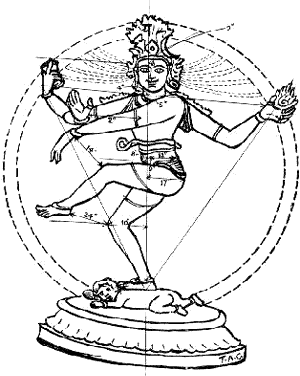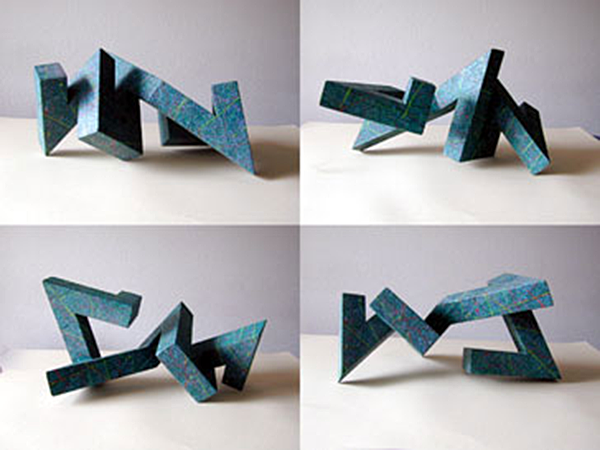cosmic dancer - a space art intervention by arthur woods
Cosmonaut Gennadi Manakov and the Cosmic Dancer, 1993
A Multi-Dimensional Artwork
The Cosmic Dancer represents a convergence of several directions in my art that I had been developing since 1976. At that time I looked to science to see what it had to say about the nature of reality. What I discovered and what has influenced my art ever since, was a description of the universe at the microcosmic level consisting of sub-atomic particles in an inseparable network of interactions.

These interactions involve a ceaseless flow of energy which gives rise to the stable structures of the material world or the macrocosmos. The structures that make up physical reality do not remain static but are transient and oscillate in rhythmic movements. Thus the entire universe is engaged in endless motion and activity: in a continual cosmic dance of energy. Both the aesthetic aspects of this description as well as the environmental implications of an interdependent and interconnected universe stimulated me deeply. The physical aspects of cosmic forces and the concept of the cosmic dance has become embodied in my art over the years.
Some particle physicists, including Fritjof Capra and Gary Zukav, have pointed out that this description of the universe was similar to that of Eastern mystics which have also used the image of the dance to convey their dynamic view of the universe.
The "Dance of Shiva", the Hindu god of creation, is the dancing universe symbolizing the cosmic cycles of creation and destruction and the daily rhythm of birth and death. I was both impressed and inspired by this seeming merging of diverse cultures and these diverse yet similar ways of describing the cosmos. This seemed to indicate that knowledge about the nature of the universe was somehow imbedded in our physical being. As we human beings are intelligent products of cosmic evolution - this insight made sense to the artist.
I have integrated this information into my art by using points of color as a basic visual element - a metaphor of a quantistic/pointillistic universe. All of my art during this time, mostly paintings and sculptures, has used some variation of this approach, both as subject matter and through artistic technique. The painted surface of the Cosmic Dancer is typical of this approach.

Reclining Dancer
Acrylic on Wood, 25 x 28 x 57 cm
Since 1981, I have created a series of sculptures that are characterized by their twisted geometric shapes. The geometric form of these sculptures enabled them to be positioned in different ways. This aspect allowed the sculptures to be viewed from different perspectives and, in relation to their surroundings, the same sculpture could appear to be a unique three-dimensional form as a result of its varied positions. Depending on the complexity of the sculpture, usually between four and eight resting positions could be found for each sculpture - the "gravity constant" being the ultimate determining factor.
The Cosmic Dancer takes this concept to its logical conclusion. By taking advantage of the micro-gravity environment found in Low Earth Orbit (LEO), the Cosmic Dancer could indeed be perceived from an infinite number of perspectives and "dance" its own dance in the cosmos.
***

Photo: a statue of Shiva Nataraja gifted by India at CERN in Geneva, Switzerland (Photo: Wikipedia)
LORD OF THE COSMIC DANCE
How the Indian icon Nataraja danced his way from ancient history to modern physics
Harish Pullanoor - December 18, 2019
This idea of the eternal universal dancer has so deeply caught on among physicists and cosmologists that in 1993, an abstract sculpture called Cosmic Dancer, was launched to the Russian Mir space station. Asked about how his artwork, its designer Arthur Woods said:
"…the (Nataraja) appears very angular yet aesthetic with the four arms outstretched and the raised front leg. Thus my sculpture, which is also very angular could be viewed as a symbolic abstraction of this figure as it dances in the cosmic weightlessness of space…its form is always in a transient state of change…This and the fact that it is free of terrestrial gravity, imparts a supranatural quality normally reserved for gods. Thus this qualitative relationship to the god Shiva can be made. "
http://bit.ly/2ZgYrlm
